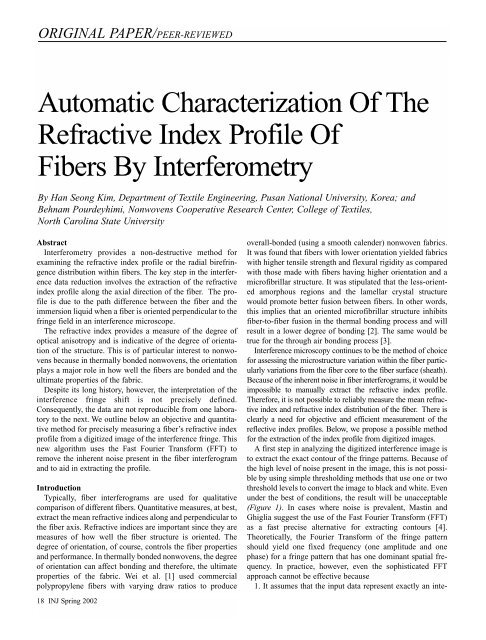2002 - Volume 1 - JEFF. Journal of Engineered Fibers and Fabrics
2002 - Volume 1 - JEFF. Journal of Engineered Fibers and Fabrics
2002 - Volume 1 - JEFF. Journal of Engineered Fibers and Fabrics
You also want an ePaper? Increase the reach of your titles
YUMPU automatically turns print PDFs into web optimized ePapers that Google loves.
ORIGINAL PAPER/PEER-REVIEWED<br />
Automatic Characterization Of The<br />
Refractive Index Pr<strong>of</strong>ile Of<br />
<strong>Fibers</strong> By Interferometry<br />
By Han Seong Kim, Department <strong>of</strong> Textile Engineering, Pusan National University, Korea; <strong>and</strong><br />
Behnam Pourdeyhimi, Nonwovens Cooperative Research Center, College <strong>of</strong> Textiles,<br />
North Carolina State University<br />
Abstract<br />
Interferometry provides a non-destructive method for<br />
examining the refractive index pr<strong>of</strong>ile or the radial birefringence<br />
distribution within fibers. The key step in the interference<br />
data reduction involves the extraction <strong>of</strong> the refractive<br />
index pr<strong>of</strong>ile along the axial direction <strong>of</strong> the fiber. The pr<strong>of</strong>ile<br />
is due to the path difference between the fiber <strong>and</strong> the<br />
immersion liquid when a fiber is oriented perpendicular to the<br />
fringe field in an interference microscope.<br />
The refractive index provides a measure <strong>of</strong> the degree <strong>of</strong><br />
optical anisotropy <strong>and</strong> is indicative <strong>of</strong> the degree <strong>of</strong> orientation<br />
<strong>of</strong> the structure. This is <strong>of</strong> particular interest to nonwovens<br />
because in thermally bonded nonwovens, the orientation<br />
plays a major role in how well the fibers are bonded <strong>and</strong> the<br />
ultimate properties <strong>of</strong> the fabric.<br />
Despite its long history, however, the interpretation <strong>of</strong> the<br />
interference fringe shift is not precisely defined.<br />
Consequently, the data are not reproducible from one laboratory<br />
to the next. We outline below an objective <strong>and</strong> quantitative<br />
method for precisely measuring a fiber’s refractive index<br />
pr<strong>of</strong>ile from a digitized image <strong>of</strong> the interference fringe. This<br />
new algorithm uses the Fast Fourier Transform (FFT) to<br />
remove the inherent noise present in the fiber interferogram<br />
<strong>and</strong> to aid in extracting the pr<strong>of</strong>ile.<br />
Introduction<br />
Typically, fiber interferograms are used for qualitative<br />
comparison <strong>of</strong> different fibers. Quantitative measures, at best,<br />
extract the mean refractive indices along <strong>and</strong> perpendicular to<br />
the fiber axis. Refractive indices are important since they are<br />
measures <strong>of</strong> how well the fiber structure is oriented. The<br />
degree <strong>of</strong> orientation, <strong>of</strong> course, controls the fiber properties<br />
<strong>and</strong> performance. In thermally bonded nonwovens, the degree<br />
<strong>of</strong> orientation can affect bonding <strong>and</strong> therefore, the ultimate<br />
properties <strong>of</strong> the fabric. Wei et al. [1] used commercial<br />
polypropylene fibers with varying draw ratios to produce<br />
18 INJ Spring <strong>2002</strong><br />
overall-bonded (using a smooth calender) nonwoven fabrics.<br />
It was found that fibers with lower orientation yielded fabrics<br />
with higher tensile strength <strong>and</strong> flexural rigidity as compared<br />
with those made with fibers having higher orientation <strong>and</strong> a<br />
micr<strong>of</strong>ibrillar structure. It was stipulated that the less-oriented<br />
amorphous regions <strong>and</strong> the lamellar crystal structure<br />
would promote better fusion between fibers. In other words,<br />
this implies that an oriented micr<strong>of</strong>ibrillar structure inhibits<br />
fiber-to-fiber fusion in the thermal bonding process <strong>and</strong> will<br />
result in a lower degree <strong>of</strong> bonding [2]. The same would be<br />
true for the through air bonding process [3].<br />
Interference microscopy continues to be the method <strong>of</strong> choice<br />
for assessing the microstructure variation within the fiber particularly<br />
variations from the fiber core to the fiber surface (sheath).<br />
Because <strong>of</strong> the inherent noise in fiber interferograms, it would be<br />
impossible to manually extract the refractive index pr<strong>of</strong>ile.<br />
Therefore, it is not possible to reliably measure the mean refractive<br />
index <strong>and</strong> refractive index distribution <strong>of</strong> the fiber. There is<br />
clearly a need for objective <strong>and</strong> efficient measurement <strong>of</strong> the<br />
reflective index pr<strong>of</strong>iles. Below, we propose a possible method<br />
for the extraction <strong>of</strong> the index pr<strong>of</strong>ile from digitized images.<br />
A first step in analyzing the digitized interference image is<br />
to extract the exact contour <strong>of</strong> the fringe patterns. Because <strong>of</strong><br />
the high level <strong>of</strong> noise present in the image, this is not possible<br />
by using simple thresholding methods that use one or two<br />
threshold levels to convert the image to black <strong>and</strong> white. Even<br />
under the best <strong>of</strong> conditions, the result will be unacceptable<br />
(Figure 1). In cases where noise is prevalent, Mastin <strong>and</strong><br />
Ghiglia suggest the use <strong>of</strong> the Fast Fourier Transform (FFT)<br />
as a fast precise alternative for extracting contours [4].<br />
Theoretically, the Fourier Transform <strong>of</strong> the fringe pattern<br />
should yield one fixed frequency (one amplitude <strong>and</strong> one<br />
phase) for a fringe pattern that has one dominant spatial frequency.<br />
In practice, however, even the sophisticated FFT<br />
approach cannot be effective because<br />
1. It assumes that the input data represent exactly an inte-

















